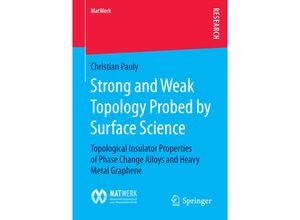Christian Pauly demonstrates the strong topological properties of the technologically relevant
phase change materials Sb 2 Te 3 and Ge 2 Sb 2 Te 5 by using two powerful techniques for
mapping the surface electronic structure: scanning tunneling spectroscopy (STS) and
angle-resolved photoemission spectroscopy (ARPES). In the case of a phase change material this
opens up the possibility of switching between an insulating amorphous and a conducting
topological phase on nanosecond-time scales. Moreover the author presents first experimental
results of a weak topological insulator namely on the bismuth-based graphene-like sheet system
Bi 14 Rh 3 I 9 revealing a topologically protected one-dimensional edge channel as its
fingerprint. The edge state is as narrow as 0.8 nm making it extremely attractive to device
physics. Those strong and weak topological insulators are a new phase of quantum matter giving
rise to robust boundary states which are protected from backscattering and localization.



